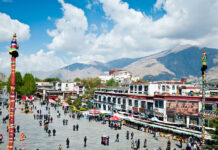(TibetanReview.net, Aug07’21) – Teams from a Chinese hospital and the Chinese People’s Liberation Army (PLA) have collected genetic samples of more than 1,20,000 Tibetans over the past 15 years ostensibly to study “plateau diseases.” The purpose is seen to be to study the genetic makeup of the Tibetan people and how this knowledge could be used to enable Chinese troops stationed in the high Himalayas to cope with high altitude, low oxygen and harsh climatic conditions.
For this purpose, China has opened in Tibet what it calls the world’s largest “plateau human genetic resources biological sample bank.”
The bank was built by expert teams from Xinqiao Hospital in Southwest China’s Chongqing after it completed a large-scale field study on plateau population of more than 100,000 people in 15 years, reported China’s official globaltimes.cn Aug 4.
The report cited the Science and Technology Daily as reporting Aug 3 that in addition to the more than 100,000 genetic samples collected by the Xinqiao Hospital, a medical research base specializing on “plateau diseases” with the 953th Hospital of the PLA Army in Shigatse in the Tibet Autonomous Region had provided an additional samples reserve of 20,000.
The sample bank aims to improve China’s medical research and health support capabilities in the plateau.
Altitude sickness commonly affects people new to high elevations where there are low amounts of oxygen. It can cause symptoms such as headache, dizziness, and trouble to breathe, sleep and eat. It can also be deadly as altitude sickness affects lungs and the brain. but the current technical means to treat it have been limited, Jin Jun, a professor from the Department of Cardiology, Xinqiao Hospital, has said.
India and China have been locked in a military stand-off at several friction points in eastern Ladakh since May last year. While the Indian Army has specialised in high altitude warfare, media reports earlier this year suggested that PLA soldiers were facing multiple challenges at the high-altitude terrain of Ladakh, noted indiatoday.in Aug 7.
“Long presence at such high altitude is not something that the Chinese troops can sustain, hence the need to build upon their physical capacity. All such biological experiments are directed toward that desired end state,” sputniknews.com Aug 6 quoted Colonel Jaibans Singh (retired) as saying.
China, in Jan 2021, admitted that troops near the Line of Actual Control often catch a cold and fever because their respiratory systems and fitness levels have not yet fully adapted to the plateau’s environment, climate, low air pressure, and oxygen scarcity, the report noted.
The report cited Indian analysts as believing that while gene mapping is a complex science and in the nascent stage of development, China seems to be making rapid strides in the collection of vast data that could be analysed using supercomputing machines and artificial intelligence.
It quoted Rahul Bhonsle, security analyst and former Indian Army brigadier, as saying, “The Chinese focus on gene mapping in Uighur and Tibet, which are traditionally non-Han populated, needs to be carefully followed up as this could be a non-consensual path for genetic modifications. The outcomes could take years if not decades.”
“Involvement of the PLA in this programme also gives another dimension of ‘genetically modified soldiers’. There are preliminary indications that the Chinese scientists and the PLA could be at least conceptually open to this concept”, Bhonsle has added.
He has said that while the results could be complex and lethal, it appears at present to be more in the realm of science fiction but needs a diligent follow-up.
Earlier this year, a report published on a Chinese military website said that the PLA has divided military training for new recruits in three stages namely – “adapt to the plateau”, “fit for the plateau”, and “applicable to the plateau”. China has allocated nearly $29 billion for Tibet in its 14th Five Year plan, indicating a massive transformation in the civil and military infrastructure in the region, the report noted.






